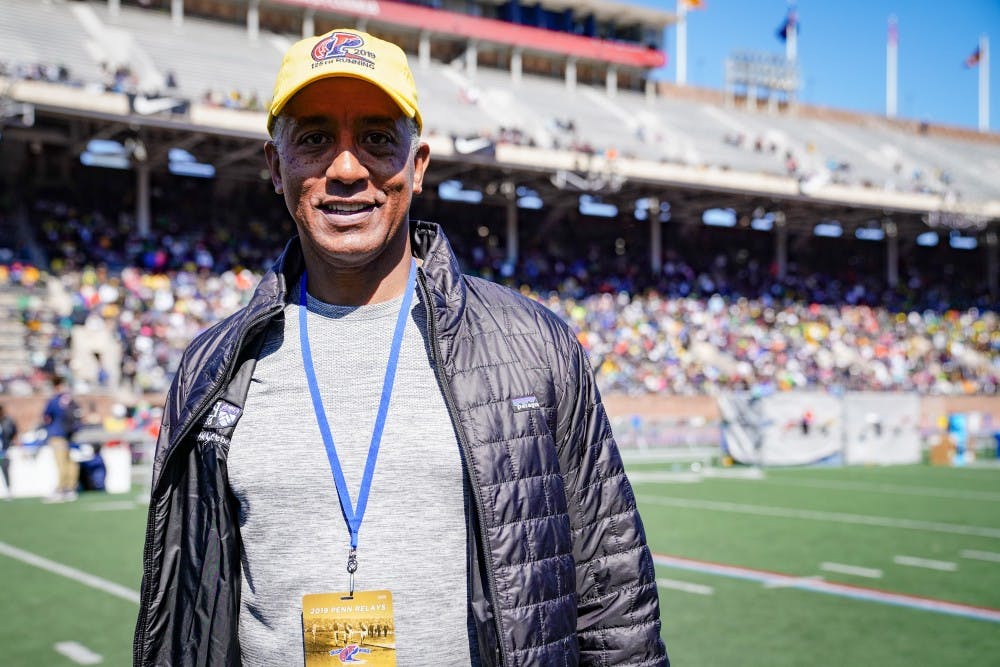Renaldo Nehemiah knows what it’s like to be the star of the Penn Relays. In 1979, running the anchor leg, he led the University of Maryland to victory in the shuttle hurdle relay, 4x200-meter relay, and 4x400-meter relay, and he earned the meet MVP award.
After his illustrious track career, Nehemiah went on to play in the NFL, despite not playing college football. He signed with the San Francisco 49ers in 1982, and played for three years before returning to the track.
This year, Nehemiah was named the Honorary Carnival Referee for the 125th Penn Relays. The Daily Pennsylvanian chatted with the track legend 40 years after his MVP meet.
Danny Chiarodit, The DP: With the Penn Relays turning 125 years old, what does that mean to you as someone who understands the history of this and has competed in it?
Renaldo Nehemiah: Well nowadays, that’s very uncommon in sports for anything to sustain itself for 125 consecutive years. But this is a mainstay in America. If you really want to make a name for yourself, male or female, this is the place where that has to start, and greatness is born here.
You see some phenomenal things. I’ve seen where it went from 10,000 to 50,000 people. In no other place, outside of maybe an Olympic trials, will you get this kind of atmosphere. And then these fans, they know everything about the sport. Some have been here 50-plus years, so they’re true track geeks.

And to me, this is just fun. It started out as a carnival, and it still is a carnival. I guess it’s the most organized, dysfunctional meet that you could ever see. So if you can drown out all the distraction of all that’s going on around here, and not exert so much energy before you even get on the track, it’s quite the event. And it’s intimidating. It has a reputation that precedes itself, so now people want to come here to leave their mark on it.
RELATED:
Several Penn recruits shine at Relays in Thursday's high school races
125 years strong: A look back at some of the biggest moments in Penn Relays history
DC: I’m sure returning and watching the athletes brings you back to when you ran here, right?
RN: Well, I come back because I love watching the high school kids. That’s where some of that unknown, untapped talent starts. When I was in high school, that’s all I heard about, the Penn Relays, so when our team qualified to make it, it was a wonderful day.
I don’t know if today’s athletes, at least non-East Coast athletes, know that much about it. They just know it’s on the schedule, and we’re going to the Penn Relays. East Coast schools, they all know about it, and then all the colleges know about it, so they come here for bragging rights.
And then for a meet that happens at the end of April, which is really the earliest of the spring seasons, guys and girls come in peak form, and if they’re not, just with the adrenaline and the enthusiasm from the fans, you see some pretty amazing performances.
DC: Having competed in some of the greatest venues, both in track and football, where does this rank for you?
RN: You know, football’s for a team, so there’s a bunch of guys that have to make it happen, and even if you’re on a relay team, at some point it’s an individual effort, so you have to do your part, and you’re either going to shine or not shine. That’s a lot of pressure; it’s all you and you can’t hide. You’re can either be the hero or the goat, and you can’t blame it on anyone else because they’re all watching your leg.
I’m from an individual sport mindset, so I’ve always had to depend on myself. But it’s a lot of pressure, especially because I was the anchor leg, so the anchor leg is supposed to be the guy that brings it home, and you can’t hide.
And I was just fortunate when I ran here that things lined up. I had a big heart, the fans were going crazy, and I ran angry because we were losing. So I was just trying to catch up, and I ended up passing my opponent.
DC: Thank you so much for your time!
RN: No problem. Thank you.









